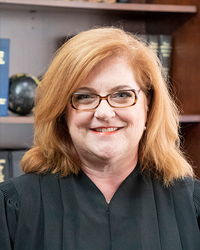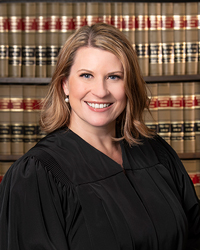This story originally appeared in Res Ipsa, the UMKC School of Law alumni magazine. To learn more, read the full issue or visit the School of Law website.
As the COVID-19 pandemic took hold, Judge Anne J. (Daddario) LaBella (J.D. ’92) was astonished to see such a large institution shift to online operations literally overnight.

“If you would have told me one year ago that our courthouse would close to the public when we were seeing upwards of 2,000 cases per day, I would have never believed it,” says Judge LaBella of the 16th Judicial Court of Missouri. “In the old days, just closing dockets for a snow day was a historic occasion.”
And yet, the courts never really closed. Hearings held during the pandemic, totaling tens of thousands in the Kansas City Circuit Court and close to 250,000 in the Municipal Court, were a constant intersection of legal reasoning, institutional integrity and technological know-how.
Each hearing dealt in real time: attorneys juggling childcare amid a hearing, staff fielding constant technical issues and, yes, some litigants participating in hearings while ordering fast food in the drive-thru.
Judge David M. Byrn (J.D. ’81), who serves as presiding judge of the 16th Circuit Court, helped lead a staff of 700, spread out through the metro area, to move court online. For him, logistics were the biggest concern — training staff on WebEx and ensuring everyone, from law clerks to records staff, could work remotely — along with keeping some semblance of a traditional hearing.
“All the process and procedures are the same: rules of evidence, due process, objections,” Byrn says. “It’s just a different way to do it.”
“If you would have told me one year ago that our courthouse would close to the public when we were seeing upwards of 2,000 cases per day, I would have never believed it.”

Judges were the crucial force in keeping everything running smoothly in their respective courtrooms. That meant repeating questions and answers when an attorney on WebEx couldn’t hear the attorney who was in person or coordinating with attorneys on scanning and email exhibits before hearings.
It also meant telling attorneys they were on mute. Often.
Judge Jessica Agnelly (J.D. ’05), appointed as an associate circuit judge in August 2020, had the unique experience of being both a practicing attorney and a judge last year.
“If anything, I had the experience of waiting in a virtual waiting room for a really long time before my case was called, wondering ‘Have I done this right? Am I in the right place?’” Agnelly says.
Virtual hearings aren’t new, but the increase in scope brought new questions for judges. Byrn says: “If you look at the court in general, courts are probably slow to change and slow to embrace change, which I would suggest is a good thing because the consistency of the courts is not necessarily responding to the back-and-forth changes that you oftentimes see in society. I think it makes the courts serve as the backbone of our democracy.”
But the courts did support adaptation. He noted rulings by the Missouri Supreme Court, which embraced virtual technology and acknowledged that due process rights are fully protected by video conference and teleconference.

Practically speaking, some aspects of hearings are very difficult to do online. Jury trials, by and large, are too difficult to hold virtually without violating due process or keeping a jury engaged. Agnelly says she’s hesitant to have preliminary criminal hearings virtually because it can impede defendants’ rights to confront witnesses at trial.
At the municipal level, some virtual hearings can be more challenging. LaBella says specialty dockets in domestic violence court, drug treatment court and mental health treatment court are extremely difficult to conduct virtually because many defendants don’t appear. The reasons vary: unfamiliarity with technology, forgetfulness or because the court cannot issue warrants for failure to appear virtually.
Still, Byrn, LaBella and Agnelly say the advantages outweigh the disadvantages. It saves attorneys travel time and money if they don’t have to drive to the courthouse for a 15-minute hearing. Virtual hearings have helped pro-se litigants, providing them more opportunities to appear and be heard.
And it has allowed judges and attorneys alike to work and raise children. When she was still a practicing attorney, Agnelly was a part of hearings while homeschooling her daughter.
“I would panic that my daughter would interrupt at the wrong time and the judge would be so angry,” Agnelly says. As a judge, “I make it a point to be as understanding as possible.”
Most importantly, Byrn says that as the pandemic eases and a new normal takes hold, it will provide something crucial for all who come before judges: “better access to justice.”
